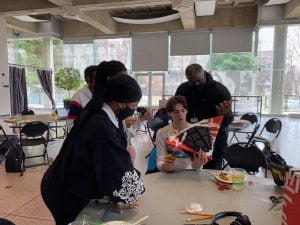
A team of Johns Hopkins researchers is working to create STEM career opportunities for students in Baltimore City schools, starting with the basics: algebra.
Joining forces with the School of Education at Notre Dame University of Maryland, the team designed and implemented an after-school program in select city schools over the last three years. The initiative, Baltimore Online Algebra for Students in Technology (BOAST), aimed to improve student’s algebra skills and inspire them to reach for futures in STEM fields.
“We wanted this program to increase the ‘dosage’ of algebra and teach it in a different way,” says Alexis Daniels, Baltimore Out of School Time (OST) Program Administrator for the Center for Educational Outreach in the Whiting School of Engineering. “It teaches algebra through engineering problems, offering a more engaging approach that demonstrates how students can apply algebra knowledge in different engineering fields.”

Instructors coach students in a soundproofing competition at JHU.
Supported by a $2.36 million grant from the National Science Foundation, the team created a curriculum taught by experienced educators and Johns Hopkins seniors. BOAST PI and co-developer Michael Falk, professor of materials science and engineering and vice dean for undergraduate education at Johns Hopkins, said “we worked with the school district directly to identify schools who were eager to have STEM programming.”
From 2021 to 2023, high school students met after school virtually and in-person, learning algebra within the context of engineering scenarios. Instead of simply solving equations, students applied algebra to real-life conditions, such as designing bridges across channels of water. This instructional method aimed to improve students’ math efficacy and spark an interest in engineering careers.
“We also made and presented what we call ‘STEM role model videos,’ which featured interviews with STEM professionals describing their pathways and what excites them about the field,” says Falk.
By the end of the program, the researchers found that virtual education had limitations, as discussed in a paper published in Education Sciences. One finding was clear: As early pandemic distancing rules relaxed and the BOAST team moved to more in-person instruction, students’ engagement and understanding improved.
“Not surprisingly, we found that the most effective part of an educational program and intervention are the human connections involved,” says Falk. “When a great instructor in the program commits to connecting with the students, that’s when we had the biggest impact.”
The team also discovered that students become more motivated to learn math as they approach graduation.

High school students at a JHU soundproofing competition.
“We initially thought that 9th grade was when students developed a ‘positive math identity’ and wanted to continue with more challenging math classes. However, we found this actually happens in 11th grade,” says Daniels. “Eleventh graders are most engaged because they’re thinking about college and want to know how to apply the algebra they’ve learned.”
Building on these insights from the after-school program, researchers are adapting BOAST into a course called “Project X: Algebra Engineering Lab.” The course will be offered to 9th through 11th graders in two Baltimore City high schools next fall.
“Using the same curriculum in a classroom setting, we hope to have higher participation and give students more voice and choice in the classes they get to take,” says Daniels “’Project X: Algebra Engineering Lab’ offers possibilities for students that BOAST wasn’t able to provide.”